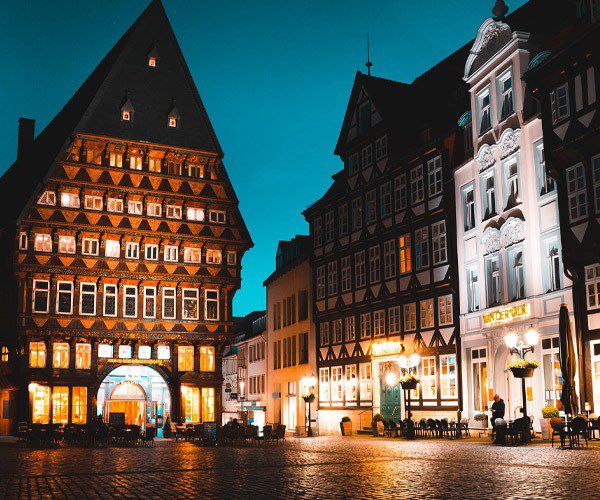
The town square of Hildesheim, Germany, is the poster child for, well, poster perfect (or picture-postcard perfect as the saying goes).
Home to beautiful half-timbered buildings, a magical, magnificent Market Square, two UNESCO World Cultural Heritage-listed Romanesque churches, and fantastic you-have-to-see-them-to-believe-them Egyptian Antiquities in the Roemer-Pelizaeus Museum, Hildesheim is definitely worthy of its bucket list status for travellers the world over. Making this picturesque place all the more impressive though? The fact that on March 22, 1945, almost all of Hildesheim’s old town, including the town square and the building pictured here, was destroyed in an Allied air raid.
Named Knochenhaueramtshaus (or the Butchers’ Guildhall), the building pictured on the left is easily the most photographed of all of Hildesheim’s famed half-timbered houses. First built on the Historic Market Place in 1529, the original burned down, along with the rest of the square, in the aforementioned air raid during the Second World War. What you see today is a replica, rebuilt in 1986. What stood here between 1945 and 1986, you ask? Sacrilege. That’s what.
In the decades immediately after the Second World War the Historic Market Place was rebuilt to ‘modern’ standards and surrounded by soulless concrete buildings. But with the resurrection of the beautiful Knochenhaueramtshaus, along with its 7,500 wooden pegs and 19,000 roof tiles, came a wave of similar restorations. Soon other buildings were resurrected, including the Bäckeramtshaus (Bakers’ Guildhall) and the Wedekindhaus, a patrician house from the late 16th century.
The end result? A restoration to its former glory, along with a rebirth as one of the most Instagrammable spots on earth. Particularly from the end of November to the end of December, when it serves as the fairytale backdrop for an idyllic Christmas market.
Even if you’re not the snap-happy type, there’s plenty in Hildesheim to keep you happy. As mentioned, it is also home to two UNESCO World Cultural Heritage-listed Romanesque churches: Hildesheim Cathedral, officially known as the Cathedral of the Assumption of Mary, or simply St. Mary’s Cathedral; and the nearby St. Michael’s Church.
And then there’s the rose… The Thousand-Year Rose.
Also known as the Rose of Hildesheim, the rose climbing the wall of the eastern apse of St Mary’s Cathedral is believed to be the oldest living rose on the planet. Twenty-one metres (69 feet) tall and nine metres (30 feet) wide, it’s believed that this wild dog rose was established by King Louis the Pious back in 815. And even though this cathedral too was completely destroyed by the Allied bombers that took out the Market Square in March 1945, the roots of the rosebush somehow survived and she blossomed among the ruins again.
According to common legend, while the rose bush flourishes, Hildesheim will prosper. Why wait to see though? There’s no time like the present to visit Hildesheim, and her rose, in all their picture-perfect glory. (Top tip: to see the rose blossom yourself, visit towards the end of May, when she shows her full-bloom glory for around 14 days.)
If you have a really special photograph you would like to share with A Luxury Travel Blog‘s readers, please contact us.





